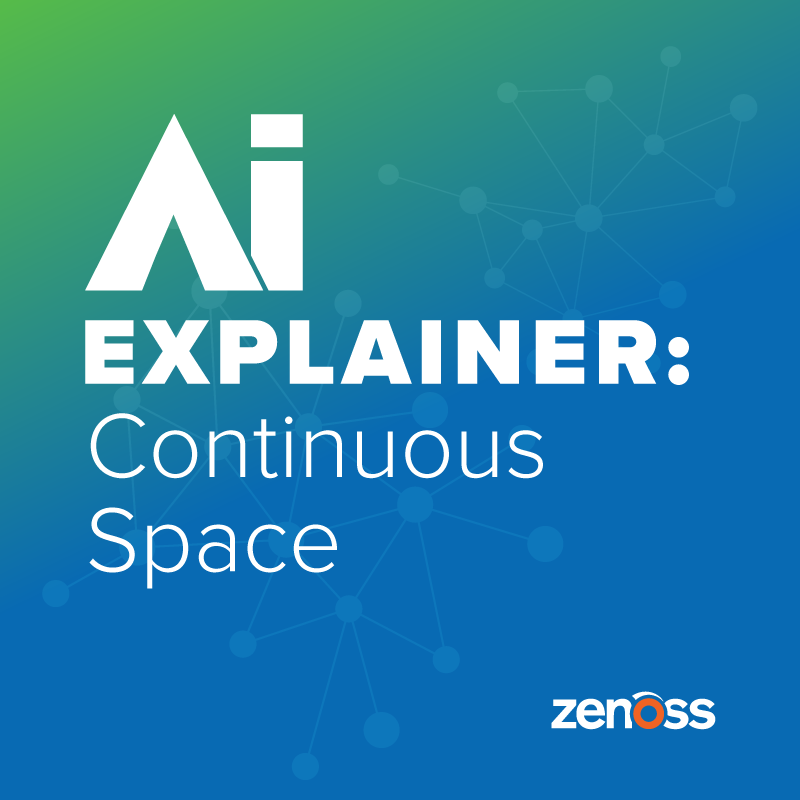I wrote a previous blog post, "AI Explainer: What's Our Vector, Victor?," to scratch the surface on vector databases, which play a crucial role in supporting applications in machine learning, information retrieval and similarity search across diverse domains. From that blog arose the topic of embeddings, which I addressed in a subsequent post, "AI Explainer: Demystifying Embeddings." In explaining embeddings, the notion of continuous space was presented, which is the topic of this blog. The embeddings blog post included this excerpt:
Isn’t an Embedding Just a Vector?
The short answer is yes. A longer answer is — a vector, in its most general sense, is a mathematical object that has both magnitude and direction and can be represented as an ordered set of numbers. In the context of vector databases, the term "embedding" is often used to refer specifically to vectors that represent entities in a continuous space, where the arrangement of vectors reflects meaningful relationships or similarities between the entities.
It seems that a key element in the distinction between vectors and embeddings is continuous space. So, what is a continuous space in this context?
In the context of vector embeddings, a continuous space refers to a space where the arrangement of vectors corresponds to a continuous and smooth representation of the relationships between entities. This is in contrast to a discrete space, where the arrangement might be more rigid and lack the nuanced gradations found in a continuous space.
Here are key characteristics of a continuous space in the context of vector embeddings:
- Smooth Transitions: In a continuous space, small changes in the vector values correspond to gradual and continuous changes in the represented entities. This property allows for smooth transitions between similar entities, making it possible to capture subtle relationships.
Example: In an embedding space where each vector represents a color, small changes in the vector values correspond to gradual changes in the color. For example, the RGB value of a light blue color (e.g., [0.5, 0.7, 0.9]) might transition smoothly to a darker blue color (e.g., [0.3, 0.5, 0.7]) with a small change in the vector values. - Semantic Similarity: Similar entities in the original data domain are represented by vectors that are close to each other in the continuous space. For example, in natural language processing, words with similar meanings have similar vector representations, and their proximity reflects semantic similarity.
Example: In an embedding space for words, vectors representing similar words are close together. For instance, the vectors for "dog" and "puppy" would be close because they have similar meanings. Similarly, the vectors for "run" and "walk" would be close because they share a semantic relationship. - Context-Aware Representations: Continuous spaces enable context-aware representations, meaning that the arrangement of vectors captures not only similarities but also context-specific relationships. This is particularly beneficial in applications where understanding nuanced relationships is essential.
Example: In a recommendation system, if a user frequently watches science fiction movies, the embedding vector representing the user's preferences might be closer to vectors for science fiction movies. However, if the user also occasionally enjoys romantic comedies, the user's vector might also have a component close to the vectors for those movies. This context-aware representation captures the nuances of the user's preferences. - Learned Representations: Continuous spaces in vector embeddings are often learned through machine learning techniques. Algorithms optimize the vector values during training to ensure that the resulting space captures meaningful patterns within the data.
Example: In a document classification task, the vectors representing documents of the same category (e.g., sports articles) are close together, while vectors representing documents of different categories (e.g., politics articles) are further apart. These learned representations are optimized during training to reflect the underlying patterns in the data. - Efficient Operations: The continuous nature of the space facilitates efficient operations such as similarity searches. Entities that are close in the continuous space are likely to be similar in the original data domain, allowing for quick and accurate retrieval.
Example: In a search engine, if a user searches for "funny movies," the search engine can efficiently find movies that are close to the embedding vector for "funny" in the embedding space. This is because similar movies are likely to be close to each other in the embedding space, allowing for quick retrieval. - Application to Similarity Tasks: Continuous spaces are particularly useful in applications where measuring similarity between entities is a key task. This includes information retrieval, recommendation systems, and natural language processing tasks like word similarity or document similarity.
Example: In a natural language processing task, if a model needs to determine whether two sentences have a similar meaning, it can compare the embedding vectors for the sentences. If the vectors are close, it indicates that the sentences are semantically similar. And if they are far apart, it indicates that the sentences are dissimilar. This application of continuous spaces is particularly useful for tasks that rely on measuring similarity.
In practical terms, when vectors are embedded in a continuous space, it means that the numerical values of the vectors are positioned in a way that reflects the underlying relationships or semantics of the data. This arrangement enhances the model's ability to capture complex patterns and relationships, making it well-suited for various AI applications.
In case you haven't seen it, this whole series started with a post that was a glossary of AI terms, which has been quite popular. Check it out, and if you want to see some of the cool things Zenoss is doing with AI, click here to request a demo.










